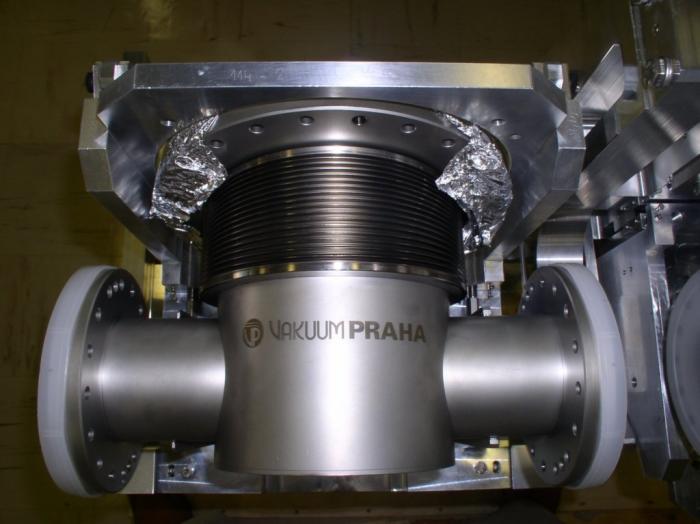At the beginning of March 2021, the TOTEM experiment from CERN’s LHC accelerator together with the D0 experiment from the former Tevatron accelerator at the Fermilab laboratory announced the discovery of the odderon [1] – a special form of matter which is formed by states composed of (at least) three gluons and which was predicted already more than 50 years ago.
The experimental discovery took a long time – it was firstly because high collision energies needed to be reached and also because several different measurement methods needed to be used so that the results were really convincing. These are based on a thorough analysis of glancing collisions of protons with protons or anti-protons when the colliding particles only slightly change their direction. These so-called elastic collisions constitute approximately one quarter of all collisions at the LHC accelerator.
At low energies, elastic collisions can be described as an exchange of virtual mesons, i.e. quark-antiquark pairs. Nevertheless, at energies of several TeV, which were used at the LHC and Tevatron accelerators, it is expected that the collisions proceed by exchanging objects composed solely of gluons which mediate the strong interaction. This expectation is (indirectly) based on quantum chromodynamics (QCD), a theory which describes the behaviour of strongly interacting particles, such as protons or anti-protons. Different formulations of this theory (perturbative, lattice) come independently to the existence of states composed of gluons only, the so called “glueballs”. These states can be internally characterised by a strong mutual interaction of gluons which is typical for QCD. From the outside, however, they look neutral form the viewpoint of the charge associated with the strong interaction, the so-called colour (similarly as an atom is neutral from the viewpoint of the electric interaction).
For a long time, the phenomenology of forward proton collisions worked relatively well with one glueball exchange, the so called pomeron, which corresponds to states composed of (at least) two mutually interacting gluons. Nevertheless, in 2018, the TOTEM experiment published a result [2] which did not fit into this simple picture. On the contrary, it indicated an exchange of other glueballs, the so called odderon, which corresponds to states composed of (as least) three gluons. This information arises from measurements of the so-called rho parameter, formally a ratio of a the real to the imaginary part of the scattering amplitudes of elastic collisions when the protons continue in (almost) unchanged direction. This measurement itself, however, was still insufficient to be sure about the odderon existence.
Another independent indication of its existence came at the end of 2020 [3]: an observation of a difference betweenthe scattering of protons on protons and protons on anti-protons, which is a key characteristic of the odderon exchange. Specifically, it involved a measurement of collisions where the particles scatter to still small but not entirely negligible angles. The data on proton-proton collisions came from CERN’s TOTEM experiment and were obtained at energies of 2.76, 7, 8 and 13 TeV. The results from these several energies allowed for an extrapolation to the energy of 1.96 TeV, where the D0 experiment in Fermilab measured the proton collisions with anti-protons. Comparison of the results showed a difference with a significance of 3.4 sigma.
The combination of results from 2018 and 2020, both of which are largely model-independent, then indicates the existence of the odderon with significance in the range of 5.2 to 5.7 sigma. Therefore we can speak of the first experimental confirmation of its existence.
The Institute of Physics joined the D0 experiment in 1998 at the time of the modernization of D0 and the Tevatron accelerator. Among other things, we contributed to the construction, operation and first analyses of the elastic scattering of protons on anti-protons from a forward proton detector, which was used to confirm the existence of the odderon.
The staff of the Institute of Physics have been involved in the TOTEM experiment since its foundation around 2004 and have made significant contributions on many levels. First, they arranged the production of vacuum-mechanical parts of proton detectors in Prague, which became an integral part of the LHC accelerator. Later, they participated in the development of reconstruction software, calibration of detectors and conducted several physics analyses – some have been discussed above in this article.
[1] Odderon discovered, 9 March 2021, CERN Courier.
[2] TOTEM Collaboration, First determination of the rho parameter at sqrt(s) = 13 TeV: probing the existence of a colourless C-odd three-gluon compound state, Eur. Phys. J. C 79, (2019) 785.
[3] DØ and TOTEM Collaborations, Comparison of pp and p-anti p differential elastic cross sections and observation of the exchange of a colorless C-odd gluonic compound, 2020, arXiv:2012.03981.

